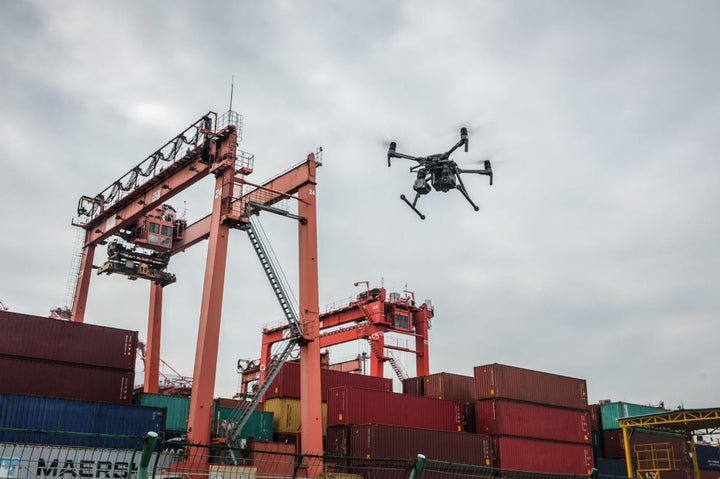Agriculture, a crucial global industry, serves as the backbone of food production. It demands physical labor to cultivate and harvest the crops that feed the world's population. Advancements in cutting-edge technologies have revolutionized various sectors, including agriculture. In recent years, drones have emerged as a game-changing tool in farming practices. This reshapes the way agricultural tasks are approached.
This article will show you how drones are changing agriculture around the world and how they are currently being used in farming. Furthermore, this will present practical applications of drone technology with real-world examples from different regions.
Applications of Drones in Agriculture
Drones can perform tedious and repetitive tasks in the fields of agriculture. This is true even if they were designed for other purposes. Drones now have many applications in agricultural practices.
Crop Surveillance and Monitoring

Farmers inspect their crops and identify any problem that needs attention. This is an essential part of tracking their crops' health. But, the traditional way is a tedious and labor-intensive task.
With unmanned aerial vehicles (UAVs), crop surveillance is now easier. Farmers would only need to launch the drone and navigate it across their land along a specified path. Since drones have cameras and sensors, they can collect real-time images and data. Farmers can then use them to check the crops’ conditions and if there is any presence of pests and diseases.
Drones for this specific purpose usually have the Normalized Difference Vegetation Index or NDVI imaging system. This measures the greenness of the vegetation on the farm. It identifies any potential areas where crops aren’t growing as well as others. For example, if the drone monitored the field as green, it means the crops in the area are healthy and growing.
Other surveying applications of drones include:
- Planting
- Field assessments
- Irrigation
Livestock Monitoring

Livestock management requires farmers to be physically present in the fields to guard and observe their animals. But, with the advent of drones, this process has been revolutionized. Farmers can now watch their livestock from the comfort of their farmhouses.
Drones have high-resolution cameras with exceptional bird's-eye view of the entire livestock area. This makes detecting any signs of injury, stress, or other health issues among the animals easier.
Moreover, the use of drones introduces a non-intrusive method of livestock management. Instead of having to herd and watch over the animals, drones can glide over them. This offers continuous surveillance without disturbing the livestock's natural behavior.
Pesticide and Fertilizer Applications

Conventional pesticide treatments and fertilizer applications are widely used nowadays. But, although manual mechanical sprayers work, using them has several disadvantages:
- Environmental pollution
- Manual farm labor
- Lower spraying uniformity
- Extra chemical usage
- Less area coverage
- Higher costs of the procedure
In addition, they’re exposed to the chemicals. This can lead to health issues like asthma, cancer, hypersensitivity, etc.
With the use of drones, farmers can mount sprayers and use them to apply pesticides and fertilizers to their crops. Some drone spraying devices can carry up to 40-liter tanks and follow a pre-mapped route to spray crops.
With drones, the drawbacks of using manual machines are lessened. Farmers can do tasks more accurately, efficiently, and faster.
Farm Security

Most farms cover over a thousand acres of land. Having human resources to secure the whole place would cost and be tedious. Even with a good number of security personnels, certain areas can be overlooked from time to time.
With a drone, everyone can save energy and time securing the whole place. The security can use and navigate the drone to track the whole place and detect any red flags.
This is possible since drones have high-quality cameras and sensors that agricultural farms can use day and night. They also offer a stable 360-degree view of the farm, making tracking anyone or anything sneakily approaching it easier.
Precision Farming

Drones enable farmers to perform precision agriculture. This means that farmers can target specific areas of their farms with the required inputs. They can integrate GPS and specialized software into drones. These are used to create accurate aerial maps and identify moisture levels. Moreover, it’s used to analyze soil compositions and irrigation needs.
With this data, they can optimize their resource allocation on the farm. For instance, they can reduce unnecessary fertilizer usage and maximize productivity simultaneously. With accurate data, farmers can make more sustainable approaches to farming. This can help them save money and reduce the environmental impacts of traditional practices or methods.
Real-Life Examples
According to Market.us, the agricultural drone market is expected to grow and exceed $11.08 billion by 2032. This shows an increasing demand for more advanced farming technologies like drones.
From OPEC Fund data and reports, here are some examples of drone technology in action when it comes to agriculture:
- Nigeria
Agricultural teams used drone imagery to make informed decisions on the layout of the rice paddies and irrigation and drainage systems for the farms they plan to build near New Busa.
- Mozambique
A project called the Third-Eye: Flying Sensors to Support Farmers’ Decision Making provided data for 2,800 smallholder farmers to help them make decisions when it comes to planning, fertilizing, and irrigating their lands. The farmers then recorded a 41% increase in crop production and a 55% increase in water productivity.
- Malawi
Drones are used to capture high-precision aerial photographs, which are used together with weather station data to analyze and predict crop yields. This is during the recurring droughts in their place.
Conclusion
Agriculture and farming serve as how individuals secure their daily sustenance. Because of the growing global population and increasing food demand, farmers worldwide are encountering mounting difficulties. Traditional agricultural methods and practices have become labor-intensive and economically inefficient in the face of these modern challenges.
Luckily, with the advancement of technology, there are now drones for farming. With this, tasks are easier and are done more efficiently. If you’re a farmer or a farm owner, you can check out our agricultural drone collection. We have kits and drones that can help you farm more efficiently!


